In the face of climate change, pollution, and diminishing natural resources, the world is undergoing a paradigm shift towards sustainability. The rapid advancement of technology has brought forward innovative solutions that are crucial in mitigating the environmental challenges we face. Among these, renewable energy technologies, green architecture, and waste recycling stand out as essential pillars in our collective effort to combat environmental degradation.
These technologies not only address immediate environmental issues, such as reducing greenhouse gas emissions and conserving natural resources but also contribute to a circular economy by encouraging resource efficiency and minimizing waste. In this article, we will explore how renewable energy, sustainable building practices, and waste recycling are working together to create a greener, more sustainable future.
1. Renewable Energy Technologies: Harnessing Nature’s Power
1.1 The Need for Renewable Energy
The global dependence on fossil fuels has contributed significantly to environmental degradation. The burning of coal, oil, and natural gas for energy production has led to air pollution, deforestation, and, most notably, climate change. According to the Intergovernmental Panel on Climate Change (IPCC), limiting global warming to 1.5°C requires drastic reductions in carbon emissions, which can only be achieved through the widespread adoption of renewable energy sources.
Renewable energy technologies offer a way to meet the world’s energy needs while reducing environmental impact. Unlike fossil fuels, renewable energy sources—such as solar, wind, hydropower, and geothermal energy—are abundant, sustainable, and produce little to no greenhouse gas emissions during operation.
1.2 Solar Energy: Capturing the Power of the Sun
Solar energy is one of the most widely adopted and fastest-growing renewable energy technologies. Solar panels, or photovoltaic (PV) cells, convert sunlight into electricity. This technology has seen remarkable advancements over the past few decades, with solar panels becoming more efficient, cost-effective, and widely accessible.
1.2.1 Solar Energy Applications
- Residential Use: Homeowners can install solar panels to reduce their reliance on traditional electricity grids. Solar energy systems allow for a more decentralized energy model, reducing both costs and dependence on fossil fuels.
- Commercial and Industrial Use: Businesses and industries are increasingly investing in solar energy to power their operations. Solar farms, which consist of large-scale solar arrays, are often situated in areas with high levels of sunlight, such as deserts, to generate electricity for local and regional grids.
- Off-Grid Solutions: In remote areas or developing countries, solar energy provides a vital source of power. Solar microgrids are an increasingly popular solution for communities without access to traditional electricity networks.
1.2.2 Technological Advancements
The solar industry has benefited from innovations like bifacial solar panels, which capture sunlight on both sides, and solar storage systems, which allow for energy to be stored for use when the sun isn’t shining. Additionally, advances in solar efficiency, such as perovskite solar cells, promise to further drive down costs and increase the adoption of solar energy globally.
1.3 Wind Energy: Harnessing the Power of the Wind
Wind energy is another rapidly growing renewable energy source. Wind turbines use the kinetic energy from wind to generate electricity. Wind power is particularly useful in regions with strong and consistent winds, such as coastal areas or open plains.
1.3.1 Onshore and Offshore Wind
- Onshore Wind Farms: These are the most common form of wind energy installation. They consist of rows of wind turbines located on land. Onshore wind power is often deployed in areas with consistent winds, such as mountain ranges or plains.
- Offshore Wind Farms: Offshore wind farms are installed in bodies of water, typically in shallow coastal areas. Offshore wind turbines have the advantage of stronger, more consistent winds, but their installation and maintenance are more expensive.
1.3.2 The Benefits and Challenges of Wind Energy
Wind power is highly efficient and can generate a significant amount of electricity without emitting greenhouse gases. However, wind energy has its challenges. The intermittency of wind means that it cannot always provide a steady supply of electricity, requiring the use of energy storage systems or backup power generation from other sources.
1.4 Hydropower: The Power of Moving Water
Hydropower has been used for centuries to generate electricity. Dams and run-of-river systems convert the kinetic energy of flowing water into electrical energy. Hydropower is one of the oldest and most reliable forms of renewable energy.
1.4.1 Large-Scale Hydropower
Large dams, such as the Three Gorges Dam in China, generate substantial amounts of electricity, often providing power to millions of people. These large-scale hydropower projects have a high energy output and are typically used for grid-scale power generation.
1.4.2 Small-Scale and Run-of-River Hydropower
Smaller hydropower systems, including run-of-river installations, have a smaller environmental footprint. These systems do not require large dams and can be deployed in rivers or streams with sufficient water flow. Run-of-river hydropower is an increasingly popular choice for rural communities and remote areas.
1.5 Geothermal Energy: Tapping into the Earth’s Heat
Geothermal energy is produced by harnessing the heat from beneath the Earth’s surface. Geothermal power plants use steam from hot water reservoirs to drive turbines and generate electricity. Geothermal energy is available 24/7, making it a reliable and consistent source of power.
1.5.1 Geothermal Applications
- Direct Heating: Geothermal energy can also be used for direct heating, such as in district heating systems that supply hot water for homes and businesses.
- Geothermal Power Plants: These plants convert heat from the Earth’s interior into electricity. While geothermal resources are geographically limited to areas with volcanic activity or tectonic plate boundaries, they provide reliable, clean power once established.
2. Green Architecture: Designing Sustainable and Energy-Efficient Buildings
2.1 The Importance of Green Buildings
Green architecture, also known as sustainable or eco-friendly design, focuses on constructing buildings that minimize energy consumption, reduce environmental impact, and maximize resource efficiency. Green buildings use energy-efficient technologies, sustainable building materials, and smart design practices to create structures that have a minimal carbon footprint.
2.2 Key Elements of Green Architecture
2.2.1 Energy Efficiency
Energy-efficient buildings use insulation, high-efficiency heating and cooling systems, and advanced lighting technologies to reduce their energy demand. Properly designed windows and natural ventilation also reduce the need for artificial lighting and air conditioning.
2.2.2 Renewable Energy Integration
Green buildings often incorporate renewable energy systems, such as solar panels and small-scale wind turbines, to reduce their dependence on traditional electricity sources. Energy storage solutions, such as batteries, are also commonly used to ensure that power is available when renewable sources are not generating electricity.
2.2.3 Sustainable Materials
Green buildings are constructed using sustainable materials such as recycled steel, bamboo, and low-emission paints and finishes. These materials reduce the environmental impact of the construction process and improve the health and safety of the building’s occupants.
2.2.4 Water Conservation
Water-saving technologies, including low-flow faucets, greywater recycling systems, and rainwater harvesting, are key features of green buildings. These technologies help conserve water and reduce the building’s overall environmental footprint.
2.3 The Benefits of Green Architecture
- Reduced Environmental Impact: Green buildings produce fewer greenhouse gas emissions, use fewer resources, and contribute less to urban heat islands.
- Cost Savings: Over time, green buildings offer significant cost savings through lower energy bills, reduced water consumption, and decreased maintenance costs.
- Improved Health and Well-being: Studies have shown that green buildings improve indoor air quality, enhance natural lighting, and contribute to better physical and mental well-being for occupants.

3. Waste Recycling: Turning Trash into Treasure
3.1 The Importance of Waste Recycling
Waste recycling is a critical component of the circular economy, which aims to minimize waste, maximize resource reuse, and reduce the demand for raw materials. By recycling materials such as paper, plastic, glass, and metals, we can divert waste from landfills, reduce pollution, and conserve valuable resources.
3.2 The Evolution of Recycling Technologies
3.2.1 Mechanical Recycling
Mechanical recycling involves breaking down materials such as plastic and metal into their raw forms to be reused in manufacturing processes. This method is widely used for items like aluminum cans, PET bottles, and cardboard. However, some materials, such as certain plastics, can only be recycled a limited number of times before they degrade.
3.2.2 Chemical Recycling
Chemical recycling, or advanced recycling, uses chemical processes to break down waste materials into their base chemicals, which can then be used to produce new products. This technology is particularly useful for plastics, which are difficult to recycle through mechanical methods.
3.2.3 Composting and Organic Waste Recycling
Composting is the process of breaking down organic materials such as food scraps, yard waste, and paper into nutrient-rich compost. This process reduces methane emissions from landfills and provides a sustainable alternative for managing organic waste.
3.3 The Role of Recycling in a Circular Economy
Recycling plays a pivotal role in supporting the circular economy by keeping materials in use for as long as possible. Instead of following the traditional linear model of “take, make, dispose,” recycling allows for the creation of a closed-loop system where materials are continuously reused, reducing the need for virgin resources and minimizing waste.
3.4 The Challenges of Waste Recycling
While recycling technologies have advanced significantly, challenges remain in ensuring that recycling systems are efficient and widespread. Issues such as contamination, inadequate recycling infrastructure, and the lack of public awareness hinder the effectiveness of recycling programs. Governments, businesses, and consumers must all play a role in improving recycling systems and ensuring that materials are properly sorted and processed.
4. Conclusion: Building a Sustainable Future
The combined efforts of renewable energy technologies, green architecture, and waste recycling are transforming the way we address environmental challenges. These technologies offer practical solutions for reducing carbon emissions, conserving resources, and promoting sustainability in all aspects of life.
As these technologies continue to evolve and scale, they hold the potential to reshape industries, improve quality of life, and create a more sustainable and equitable world. By embracing these innovations, we can build a greener future that supports both human progress and the health of the planet.












































